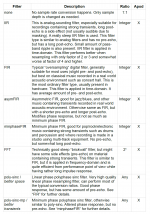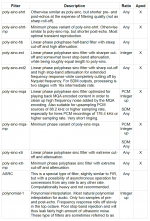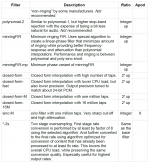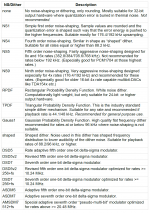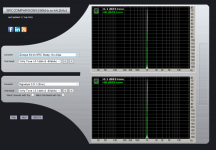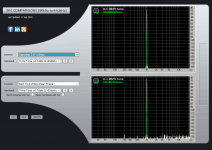Have you tried software oversampling?
Do you distinguish between oversampling and upsampling?
I use Linux full time so not entirely familiar with RMAA and the variety of windows based tools.
No idea. I use mostly RMAA and ARTA. What test signal do you have in mind?
Do you distinguish between oversampling and upsampling?
No not really. I assumed true NOS doesn’t sound good on this DAC. The difference is when the DAC is running in OS mode where the upsampling takes place. You have tried software upsampling and bypassing fir1 right?
Yes, i have run it in true NOS mode. Have to agree, it sounds terrible, perhaps even worse than NOS on other dacs. A mystery why. Of course upsampling is an improvement upon NOS, but i still prefer the oversampling filters.
As there are many who are in love with NOS type sound and would not listen to anything else, it is perhaps not unusual if we have different preferences towards upsampling/oversampling.
I remember well the mass hysteria about upconverting to dsd. Do not understand it but certainly acknowledge it. People tend to have very different tastes.
As there are many who are in love with NOS type sound and would not listen to anything else, it is perhaps not unusual if we have different preferences towards upsampling/oversampling.
I remember well the mass hysteria about upconverting to dsd. Do not understand it but certainly acknowledge it. People tend to have very different tastes.
Yes, i have run it in true NOS mode. Have to agree, it sounds terrible, perhaps even worse than NOS on other dacs. A mystery why. Of course upsampling is an improvement upon NOS, but i still prefer the oversampling filters.
As there are many who are in love with NOS type sound and would not listen to anything else, it is perhaps not unusual if we have different preferences towards upsampling/oversampling.
I remember well the mass hysteria about upconverting to dsd. Do not understand it but certainly acknowledge it. People tend to have very different tastes.
I read everything in the filter brewing thread except the first 20-30 pages which might've contained useful information on NOS. As far as I know even in NOS dam1021 might still be running in oversampled mode, except the samples are processed differently to imitate no oversampling. I'm trying to find out if newNOS is still running butterworth filter in fir2, which should do more good than harm.
I'm surprised to hear you tried software upsampling to 384khz with NOS filter settings and didn't like it. Like danny and Jogi said, the improvement in smoothness is incredible, without sacrificing the resolution or clarity or bringing in more low-end like Soren's filters. Soundstage etc. also improves quite dramatically imo. I can't comment much more about the sound. Maybe TNT can chime in once he get back to his dam1021... I recall him having a USB module paired with it...
If the NewNOS preserves the FIR2, which I would want, then there appears to be no reason why the foobar upsampling would perform worse than FPGA upsampling, provided they have the same filters. In this case, I'm convinced that Resampler-V is more powerful than FPGA due to the (at least) 8 times longer filters available. You need to have a very strong argument supported by facts to convince me that the change in sound is due to a degradation in processing.
Sox and SSRC sounds pretty much the same to my ears with the default settings. Please give it a try.
Edit: actually feeding in 384Khz should bypass any FIR1 filter. I tested it with EQHQv5 apo and NewNOS, can't say I heard a difference. But maybe NewNOS is less desirable if it bypassed FIR2.
Edit2: If anyone is wondering why no one compared internal filters with software solutions on the other thread: Filter brewing for the Soekris R2R
Edit3: Also note that the development of the latest Fb2k upsampling plugins happened just in the past couple of years, way after the filter brewing thread started outputting work.
Last edited:
Filter brewing for the Soekris R2R I honestly don't mind having high CPU usage to get better upsampling, at least sometimes. In any case, SSRC takes about 1% CPU and it runs 8x longer filters than what Paul had to work with. Izotope in A+ is capable of 1M+ taps, I doubt that software needs a supercomputer.
To put things into a bit of perspective, the FPGA Chord Dave used to get to 160k taps probably costs $150 more a pop than the one in dam1021. I'd rather compute things on my laptop to save that money and dissipate heat far away from the R2R ladders.
Some confirmation: fixed point - What are the largest FIR filter lengths used in practice? - Signal Processing Stack Exchange
To put things into a bit of perspective, the FPGA Chord Dave used to get to 160k taps probably costs $150 more a pop than the one in dam1021. I'd rather compute things on my laptop to save that money and dissipate heat far away from the R2R ladders.
Some confirmation: fixed point - What are the largest FIR filter lengths used in practice? - Signal Processing Stack Exchange
Last edited:
As far as I know even in NOS dam1021 might still be running in oversampled mode, except the samples are processed differently to imitate no oversampling.
I have no idea what this means, but i really don't understand this subject well.
The oscillograms at output look exactly what NOS should look like - the exact number of points as one would expect for the given Fs and frequency. The impulse response is also as expected. Can it be any more NOS than this?
I have no idea what this means, but i really don't understand this subject well.
The oscillograms at output look exactly what NOS should look like - the exact number of points as one would expect for the given Fs and frequency. The impulse response is also as expected. Can it be any more NOS than this?
You can produce it with padded samples no?... Intuitively, what's the difference between 1,0,1 @10hz and 1,1,0,0,1,1 @ 20hz sampling rate on the oscillograms. The sampling rates are indeed different though.
FFT plot is a different thing
Last edited:
These extra samples are being just repetitions? If you cannot tell it apart by looking at the samples why would it produce a different FFT?
Not easy to disprove with measurements without a reconstruction filter.
Different sampling rates. A real square wave consists of very high frequencies. What you see on the oscilloscope would not contain those frequencies if the signal is actually say 96Khz. Sampling theorem says 96Khz reproduces signals up to 48Khz no?... Regardless I'm not too worried now, seems like NewNOS is real NOS in signal output (hopefully) except that dam1021 clock still runs at 3Mhz most likely. I run my dac with EQHQv5 apo filter now just to keep the FIR2. Maybe it is the same butterworth as stock, and there probably isn't that much difference if it's not. I do think there is a theoretical difference between having FIR2 and not having it - I prefer the former (but maybe I'm wrong to do so), and the DAC is designed for it. Can't spot a difference in the sound though.
Do you have a USB receiver? You need to just try it. It's what you'd expect from a natural sounding and warm NOS dac, but probably with a flat frequency response.
Edit: Filter brewing for the Soekris R2R Explanation from Paul on how NOS works. Should agree with my simple example earlier.
I hope everyone is busy trying the software upsampling.
Last edited:
I came back with some interesting data. Tried Audirvana, turned out V3 is only for Mac. On windows only SoX is offered at 300k max tap. Disappointment. Together with the terrible GUI, I would hesitate to use the software even if they pay me the $100 listed price.
Then tried HQPlayer Pro (filters should be same as Desktop). I was amazed by the options offered (see attached manual for details). closed-form-M (16 million taps! Note the Chord Dave uses its own closed-form filter at 164K taps) had weaker bass than poly-sinc-xtr, and probably less natural too. They consume about 3% of CPU. sinc-m (1 million taps) is not recommended as it consumes more resources. Indeed, it actually offloads to CUDA every now and then. Consumes about 3% CPU plus the occasional GPU usage. Very well-constructed software. I couldn't quite hear the difference between sinc-m and poly-sinc-xtr, they're probably similar anyways in resampling performance. I didn't spend much time on other poly-sinc as they're probably shorter and they do appear to consume slightly less computation resources.
Now the most interesting part. Compared to fb2k SoX, the poly-sinc-xtr is clearly softer and more natural, in the exact same direction of change from the FPGA filters to the SoX filters, as far as I can tell. I would conclude that poly-sinc-xtr is superior by quite a wide margin. Can't find exact details on the filter construction but I would guess that it's in the 1M taps ballpark based on its similarity with sinc-m in the verbal description.
Used NS5 noise shaping because it seems the most suitable for 353/384Khz upsampling, but can't say I hear a difference. I trust that it's theoretically beneficial though.
Test track is Tchaikovsky Sym.5 4th movement by LPO/Mravinsky in 24/96. Instrumentally complex piece imo and sounds quite horrible with FPGA filters, relatively in this case of course... It's probably above average in the range of frequencies/instrument timbres that it showcases. Mostly used 3:00-3:30 and 4:00-4:30 in the A/B tests.
Unfortunately we can't use HQPlayer filters in Fb2k... the fb2k interface, though simple, is still miles ahead in my opinion...
Edit: more info on the filters by the person who wrote the HQPlayer manual: hqplayer resampling filter setup guide for ordinary person - General Forum - Audiophile Style
Then tried HQPlayer Pro (filters should be same as Desktop). I was amazed by the options offered (see attached manual for details). closed-form-M (16 million taps! Note the Chord Dave uses its own closed-form filter at 164K taps) had weaker bass than poly-sinc-xtr, and probably less natural too. They consume about 3% of CPU. sinc-m (1 million taps) is not recommended as it consumes more resources. Indeed, it actually offloads to CUDA every now and then. Consumes about 3% CPU plus the occasional GPU usage. Very well-constructed software. I couldn't quite hear the difference between sinc-m and poly-sinc-xtr, they're probably similar anyways in resampling performance. I didn't spend much time on other poly-sinc as they're probably shorter and they do appear to consume slightly less computation resources.
Now the most interesting part. Compared to fb2k SoX, the poly-sinc-xtr is clearly softer and more natural, in the exact same direction of change from the FPGA filters to the SoX filters, as far as I can tell. I would conclude that poly-sinc-xtr is superior by quite a wide margin. Can't find exact details on the filter construction but I would guess that it's in the 1M taps ballpark based on its similarity with sinc-m in the verbal description.
Used NS5 noise shaping because it seems the most suitable for 353/384Khz upsampling, but can't say I hear a difference. I trust that it's theoretically beneficial though.
Test track is Tchaikovsky Sym.5 4th movement by LPO/Mravinsky in 24/96. Instrumentally complex piece imo and sounds quite horrible with FPGA filters, relatively in this case of course... It's probably above average in the range of frequencies/instrument timbres that it showcases. Mostly used 3:00-3:30 and 4:00-4:30 in the A/B tests.
Unfortunately we can't use HQPlayer filters in Fb2k... the fb2k interface, though simple, is still miles ahead in my opinion...
Edit: more info on the filters by the person who wrote the HQPlayer manual: hqplayer resampling filter setup guide for ordinary person - General Forum - Audiophile Style
Attachments
Last edited:
No need for superlatives; everyone has to try it out.
Latest version of HQPlayer Desktop is 3.25.2. You probably don't have to pay $150 to try out the sound, for as long as you want...
This is probably nearly perfect for FIR1. If DSD512 still gets converted to 384Khz PCM inside dam1021 then there's no point in giving your CPU extra work. 353/384Khz input is the best we can do.
Soren can you test this and see what you think? Also, could there be a chance that freeing up blocks from FIR1 duty can give FIR2 more resources to perform better? This is something that cannot be outsourced to PCs.
Now we might actually have a genuine advantage over regular R2R chips. I wouldn't trust PCM1704 to x8 oversample my 96Khz input. As for TotalDAC, we can ask to compare waveforms. Too bad Denafrips got way ahead in the THD game.
Too bad Denafrips got way ahead in the THD game.
Latest version of HQPlayer Desktop is 3.25.2. You probably don't have to pay $150 to try out the sound, for as long as you want...
This is probably nearly perfect for FIR1. If DSD512 still gets converted to 384Khz PCM inside dam1021 then there's no point in giving your CPU extra work. 353/384Khz input is the best we can do.
Soren can you test this and see what you think? Also, could there be a chance that freeing up blocks from FIR1 duty can give FIR2 more resources to perform better? This is something that cannot be outsourced to PCs.
Now we might actually have a genuine advantage over regular R2R chips. I wouldn't trust PCM1704 to x8 oversample my 96Khz input. As for TotalDAC, we can ask to compare waveforms.
Attachments
Last edited:
Btw, the reduced harshness allowed me to turn up the volume by ~4db without any discomfort, just realized I was set on -23db when I usually don't go higher than -27db after listening to an entire symphony... No doubt greatly improved dynamics. You Europeans need to wake up and try this...seriously
Spending time in this thread has significantly disturbed my sleep schedule because TNT and friends always manage to reply when it's 1am here and then I can't resist staying up just a little later... But I think the success in recent developments, if verified, must be attributed to our German friends who came up with the ideas we all overlooked... Especially danny, living sounds and Jogi.
Spending time in this thread has significantly disturbed my sleep schedule because TNT and friends always manage to reply when it's 1am here and then I can't resist staying up just a little later... But I think the success in recent developments, if verified, must be attributed to our German friends who came up with the ideas we all overlooked... Especially danny, living sounds and Jogi.
Last edited:
And to those who haven't purchased the dam1021: get the 1121 or 1941... TNT was right - not placing reclocking after the FPGA processing does seem a pretty big screw-up, regardless of audibility. To be fair to Soren, there's no space on dam1021 even rev.4/5 to add those flip-flops before the ladder while maintaining the original physical dimensions. So, if you don't absolutely have to cut corners on separating analog and digital power supply, or can't find good +/-5V supplies, or must use the onboard buffered output, get yourself something theoretically better than dam1021.
You're welcome.
P.S. This is unless Soren start to genuinely care about the helpful and loyal dam1021 users and finally release the addon headphone amplifier board after however many years since the first mention of it... In that case, the setup for dam1021 would be much more elegant in comparison. I guess there is hope
You're welcome.
P.S. This is unless Soren start to genuinely care about the helpful and loyal dam1021 users and finally release the addon headphone amplifier board after however many years since the first mention of it... In that case, the setup for dam1021 would be much more elegant in comparison. I guess there is hope
Last edited:
ynmichael, Yeah so I have been running audacious with libsoxr resampling and running with the correct mappings to upsample to 384 or 352.8, extra CPU usage in audacious is minimal. I had to edit the source to add mapping and other knobs to the plugin that were missing. The dynamics have changed significantly, again not a subtle change! Almost like removing a veil that muffles the music. It's funny as you can select the plugin on and off in audacious realtime and hear the difference (while seeing the dac display go from 44.1 to 352.8)
Now to debug why audacious crashes everytime I seek...
Now to debug why audacious crashes everytime I seek...
ynmichael, Yeah so I have been running audacious with libsoxr resampling and running with the correct mappings to upsample to 384 or 352.8, extra CPU usage in audacious is minimal. I had to edit the source to add mapping and other knobs to the plugin that were missing. The dynamics have changed significantly, again not a subtle change! Almost like removing a veil that muffles the music. It's funny as you can select the plugin on and off in audacious realtime and hear the difference (while seeing the dac display go from 44.1 to 352.8)
Now to debug why audacious crashes everytime I seek...
libsoxr is inferior, not suitable for Soekris products.
Dynamics is important but naturalness is the most critical improvement imo...dynamics kind of just follows... (who knows how these causations work anyways....
Edit: you don't want this in your system...see picture. Signalyst is HQPlayer
Edit2: in HQPlayer, check "auto rate family" and choose 384khz as max for 44.1khz to map automatically to 352.8khz. Just found out about it.
Attachments
Last edited:
libsoxr is inferior, not suitable for Soekris products.Get a trial for HQPlayer Desktop 3. I shouldn't say this but Russians have posted cracked exe for it so feel free to try it out.
Dynamics is important but naturalness is the most critical improvement imo...dynamics kind of just follows... (who knows how these causations work anyways....) Check out violin performances or orchestral pieces with certain percussion or brass instruments etc. High frequency harshness reduces even further going from SoX to HQPlayer
Edit: you don't want this in your system...see picture. Signalyst is HQPlayer
Edit2: in HQPlayer, check "auto rate family" and choose 384khz as max for 44.1khz to map automatically to 352.8khz. Just found out about it.
I only now noticed there was a Linux version, excited to try it out.
I only now noticed there was a Linux version, excited to try it out.
Nice!
You may or may not notice that it's suddenly easy to identify pitch in bass voices
I'm not trying to become an audiophile...
Last edited:
- Status
- This old topic is closed. If you want to reopen this topic, contact a moderator using the "Report Post" button.
- Home
- Source & Line
- Digital Line Level
- Musings on soekris Reference Dac Module
